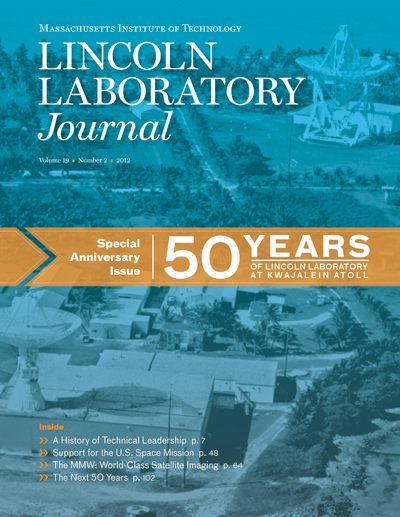Lincoln Laboratory Journal - Volume 19, Number 2
Special Anniversary Issue
50 Years at Kwajalein Atoll

History of Lincoln Laboratory at the Reagan Test Site
John A. Nelson and Kenneth R. Roth
In 2012, MIT Lincoln Laboratory celebrates 50 years of continuous service on the Kwajalein Atoll. Since the first Laboratory staff arrived on the atoll in 1962 to take on the responsibilities of scientific director to Project PRESS (Pacific Range Electromagnetic Signature Studies), personnel from the Laboratory have been supporting technology development and operations at the Reagan Test Site (RTS), formerly known as Kwajalein Missile Range. With the technical support of Lincoln Laboratory, now serving as scientific advisor to the site, the RTS has been a critical contributor to the ballistic missile defense and space situational awareness national missions. In addition, many important technologies had their beginnings and many science experiments leading to improved understanding of the Earth and our universe have been carried out at RTS and the Kiernan Reentry Measurements Site.
Historical Timeline
Kenneth R. Roth
Events at the Reagan Test Site.
The Space Mission at Kwajalein
Timothy D. Hall, Gary F. Duff, and Linda J. Maciel
The United States has leveraged the Reagan Test Site’s suite of instrumentation radars and its unique location on the Kwajalein Atoll to enhance space surveillance and to conduct space launches. Lincoln Laboratory’s technical leadership at the site and its connection to the greater Department of Defense space community have been instrumental in the success of programs to detect space launches, to catalog deep-space objects, and to provide exquisite radar imagery of satellites.
The 4 GHz Bandwidth Millimeter-Wave Radar
Justin J. Stambaugh, Roy K. Lee, and William H. Cantrell
The Millimeter-Wave Radar (MMW) on Roi-Namur is the highest resolution, highest metric accuracy radar at the Reagan Test Site on Kwajalein Atoll in the Marshall Islands. Originally designed as a 1 GHz bandwidth Ka- and W-band adjunct to the Advanced Research Projects Agency Lincoln C-band Observables Radar, the original charter for MMW was to provide a database of millimeter-wave signature data of missile reentry phenomenology. MMW has been upgraded several times over nearly 30 years of operations in response to evolving missions and requirements. Most recently, a 4 GHz bandwidth capability (33.0 to 37.0 GHz) was added that improves the radar image resolution to 6 cm, making MMW the highest-resolution coherent instrumentation radar in the world.
Reagan Test Site Distributed Operations
Timothy J. O’Rourke, John A. Nelson, and John G. Volan
A transformational program fundamentally changed mission execution and operations at the Reagan Test Site on the Kwajalein Atoll. The site has become a globally operated test range through the use of a recently installed fiber-optic cable connecting communications between the atoll and Guam, and the development of an open system architecture that enables remote, distributed operation of the radar systems at Kwajalein.
Ionospheric Science at the Reagan Test Site
Stephen M. Hunt, Frederick J. Rich, and Gregory P. Ginet
The Reagan Test Site is located just north of the geomagnetic equator below one of the most complex regions of Earth’s ionosphere. For nearly 50 years, the site’s advanced radar technology and precise measurement techniques have provided comprehensive data on the physical properties of the equatorial ionosphere and radio-wave signal propagation effects.
Kwajalein: The Next Fifty Years
Kurt Schwan
Looking back is the role of other articles. This one looks forward.